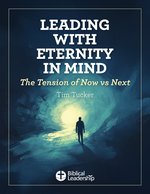Looking at the numbers of congregational change
 iStock
iStock
When we look at the numerical aspects of congregational change, here's what we see.
One …
of the most serious issues that congregations face is apathy. Former Utah Jazz basketball coach Frank Layden pressed a player: "Son, what is your problem? Is it ignorance or apathy?" The player responded: "Coach, I don't know, and I don't care."
According to consultant Bill Easum, the number one issue for the future of most congregations is: Are you so focused on current membership that you are apathetic toward connecting and networking with the unchurched and bringing them through the front, side and back doors?
Two …
catalysts for spurring a congregation to new vitality according to authors Norman Shawchuck and Lloyd Perry in their book Revitalizing the 20th Century Church (p.15) are "a vision or a calamity."
Some observe that change is truly motivated either by one of two types of fire: one that burns down the building or when the fire of the Holy Spirit ignites members' hearts.
Twoways people begin to change were shared by humorist Will Rogers who provided social commentary in the era when a large percentage of Americans had gardens and kept a cow or two. He observed that a few persons understand the need to change by reading or observing while a larger group "needs to pee on the electric fence themselves" to check if it's working.
Three …
times when people will change according to author John Maxwell are: when they hurt enough, when they learn enough, and when they receive enough empowerment to change.
Four …
words beginning with the letter "T" help to avoid alienation amidst transition. Several management experts propose that these are "trust," "talking," "time" and "tolerance."
The average tenure of a professional coach across the four major USA sports is 3.3 years. The average tenure of a pastor across denomination lines is under four years.
Five to 14…
often represents the best years for a congregation of a pastor's tenure according to Wisdom from Lyle E. Schaller edited by Warren Bird. (p. 157)
10 …
minute rules include the following.
According to evangelism professor Ben Campbell Johnson, first-time visitors to a church will likely make up their minds about returning within the first 10 minutes after seeing the church door.
On the other hand Gary L. McIntosh and Charles Arn in their book What Every Pastor Should Know (p.35) report: "The10 minutes immediately following the worship service are the most important minutes in your guest's visit."
Both of these observations have to do with the attentiveness and friendliness of the congregation. Does this mean that churches need both greeters and after-service hosts?
10 to one …
The same energy it takes to get one drop-out member of a congregation to return equals the same energy to get 10 new members.
10 to 12 ...
influential congregants who return from a retreat or intentionally visiting another congregation "to hold up a mirror" can spur rapid major change in a congregation.
A 12 percent ...
drop was indicated in a 2015 Hartford Institute report about congregations willing "to change to meet new challenges." In 2005, 74 percent of churches claimed they were willing to change. The number had decreased to 62 percent in 2015.
What is that percentage now when many individuals have become catatonic amidst COVID, hyper-inflation, and horrid images of war?
One ...
thing biologist Garrett Hardin has observed: "You can never merely do one thing." Making a change will be the catalyst for other reactions—positive and negative.
The One and Only ...
Most High God is the real change agent. As Isaiah 43:19 reads: "Behold I will do a new thing."
| Jim Farrer is the founder of Vital Signs Church Consulting and a member of the Society for Church Consulting. A broadly-trained church consultant, Jim is also a veteran of ministry positions in Canada and the U.S., he has trained leaders from 18 denominations and led seminars and coaching sessions nationwide. His articles have been published in the Journal of Evangelism and Missions and the Great Commission Research Journal. You can reach him by e-mailing revup1@yahoo.com or calling 814 629-5211. Learn More » |
More on Leadership Development & Discipleship
- The four faces of the nones: what Ryan Burge’s new research reveals (by Thom Rainer)
- Do you bury or bite when giving feedback? (by Miranda Carls)
- Six holiday and new year stress strategies from Jesus (by Jim Farrer)
- Feedback isn’t punishment: it’s one of the greatest gifts you can give your team (by Jenni Catron)


